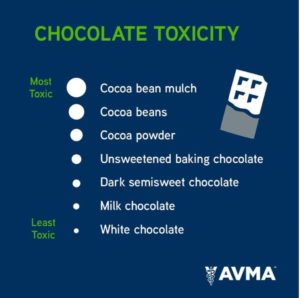
It’s that time of year when the house is filled with delicious treats. Among those sweets is usually the one we all know and love: chocolate. While it may be a sweet snack for you, it is dangerous for your pet. Here is what you need to know if your pet indulges in a little chocolate sampling of their own.
Chocolate is made of two toxic ingredients: theobromine and caffeine. They can have a range of adverse effects depending on the dose consumed. Low toxic doses present with gastrointestinal upset, resulting in loss of appetite, vomiting, and diarrhea. Higher doses of chocolate can affect cardiovascular and neurologic systems which results in elevated heart rate, changes in blood pressure, abnormal heart rhythm, hyperexcitability, tremors, or seizures.
Other ingredients in chocolate can cause pancreatitis which is an inflammation of the pancreas. This can lead to vomiting, loss of appetite, and acute abdominal pain. The ingestion of low doses of chocolate is usually treated with decontamination including induction of vomiting and activated charcoal. Higher doses may require hospitalization with IV fluids and heart rate monitoring.
Chocolate can stay in the system for up to 72 hours. Because of this close monitoring and restricted activity for the next 3-4 days are in your pet’s best interest. Activity restriction includes short leash walks with no running, jumping, or rough play. The toxins in chocolate can be reabsorbed through the urinary bladder. Frequent small walks or outside breaks are recommended to allow urination and keeping the bladder empty.
Watch for any of the following signs: vomiting, diarrhea, loss of appetite for more than 24 hours, restlessness, excessive panting, excessive vocalization, hyperactivity, behavior change, tremors, or seizures. Seek immediate veterinary attention if you notice any of these symptoms.
If your pet receives activated charcoal with a veterinary professional your pet may have black feces for the following 12-24 hours. Activated charcoal is given to bind the toxins in chocolate, prevent them from absorption, and cause them to pass through the GI tract rapidly. We recommend that you keep your pet in a non-carpeted area that can be easily cleaned. If the feces continue to be black or any other abnormal color or are a watery consistency, please contact a veterinarian.
Ranging in succession from most toxic to least toxic chocolates are:


